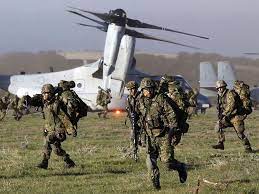Sajjad Ashraf
While the Western leadership and the media has been obsessed with the conflict in Ukraine since early 2022 another military buildup is taking shape in North Asia. Describing Japan and its people at a “turning point in history” a few months back, the Prime Minister Fumio Kishida unveiled a $320 billion military spending till 2027. Doubling the current military outlay to 2 percent of the GDP, bringing it at par with NATO members contribution, will make Japan the world’s third biggest military spender after the US and China.
The new Defense Buildup Program under which this money will be spent signals the most significant changes to Japan’s security strategy since the end of World War II. This reverses Japan’s pacifist defense policy followed since 1946 under Article 9 of the constitution that mandated use of military only in case of an attack on Japan’s territory or its people. Then prime minister Shinzo Abe obtained legislative approval in 2015 allowing the Self Defense Force (SDF) to engage in combat missions overseas. Japan therefore, feels the need to update its military potential to respond to what it perceives as deteriorating regional and international security environment as well as “expectations from its longstanding ally the USA.” No wonder, President Biden was quick to offer ‘strong support for Japan’s updated national security policies as a significant evolution that bolsters alliance’s deterrence.’ North Korea’s missile testing and its increasingly threatening posture ostensibly makes Japan feel the need for possessing its independent missile arsenal and interceptors. Similarly, war in Ukraine has rattled Japan for it too has unresolved territorial disputes with Russia and China.
The Japan-US military alliance is the bedrock of Japan’s defense strategy since 1951. But China and Japan have deep commercial relations (2022 trade $333.40 billion) where the former is already Japan’s biggest trading partner. In contrast growth in Japan – US economic relations (2022 trade $230.46 billion) have been much slower. But despite these deep connections with China, Japan has activated the Quadrilateral Security Dialogue (QUAD) alongside US, Australia and India through joint military exercises, intelligence sharing, mutual access to each other’s military facilities and high-level dialogue. In December 2022 Japan announced a joint program with Italy and UK to develop a new combat aircraft. With UK and Australia Japan has signed reciprocal access agreements, moves that China has criticized. Japan does not have a major dispute with China. They are not geo-political competitors. The American forces are stationed in Japan, South Korea, the Philippines, Australia and Guam. Why then is Japan raising the military stakes? Does this new military posture provide Japan with more security? Japan is ostensibly arming because of the threat it perceives from China, even though Beijing may have benign intentions. Japan’s military rethinking bolsters, at least in the short term, the American led military buildup in the Western Pacific region. But given Japan’s intimate commercial connections with China, what reaction it is likely to generate amongst China, Russia and other states in the region is doubtful. The international community needs to understand that China’s rise is both natural and ongoing. It is unstoppable. Geopolitics is undergoing a huge change and the one thing that is for sure is that we have not reached the ‘end of history’.







